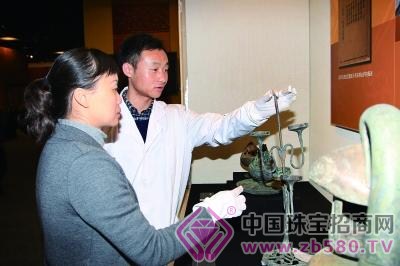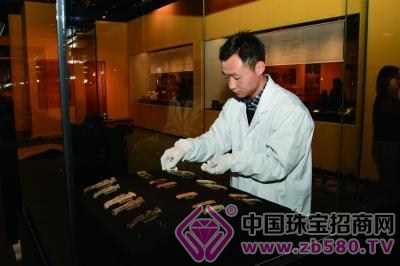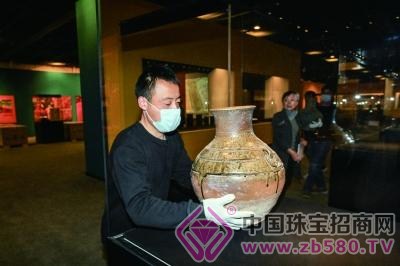The staff is at the exhibition of horseshoe gold A large number of jade artifacts unearthed from the tomb of Haiyin Hou will be on display In the ruins of the sea, there are many unearthed utensils. In this exhibition, bronze is the absolute protagonist The "Five-Colored Hyun" Nanchang Han Dynasty Haishui Houguo archaeological achievements exhibition will be unveiled at the Capital Museum on March 2 for a period of three months. This morning, the reporter learned that the exhibition will reveal the mystery of the tomb owner's identity with detailed material evidence and documentary evidence through the dialogue between cultural relics and literature. The reporter understands that the exhibition has taken an appointment to visit. As of this morning, the 1,000 reservations for the first day of the exhibition have all been fully filled. In addition, the appointments for the two days on March 5 and 6 are full. Visitors can choose other time periods to view the “Online Appointment†channel on the homepage of the official website of the Capital Museum. Since the cultural relics of the sea fainted tombs have been stationed in the first blog, from the exhibits storage, unpacking, and exhibition, the first blog has sent "fine soldiers" to participate in the whole process, in order to maintain the humidity inside the showcase, 30 constant humidity "private rooms" were created. Jade exhibits are "independent." In addition, the lighting of each group of bronzes is specially debugged by the staff to achieve the best exhibition effect. Progress horseshoe gold, lining gold "into" exhibition hall "Five-color dazzling", taken from the statement in the "Long Gate Fu" of Han Fuzhong Sima Xiangru, "Five Colors and Brightness". The meaning from Han Fu is consistent with the era revealed in the exhibition. The sentence itself is also a good description of the cultural relics. The gold, bronze and lacquer wood are all brilliant and dazzling. According to the curator's introduction, the name of the exhibition is not only an objective description of the value of the cultural relics, but also an academic summary of the Han Dynasty culture interpreted by the exhibition. Since yesterday, the "baby" of the owner of the sea faint tomb has been "into" the exhibition hall. The Capital Museum has specially built more than 30 single-contained and constant-humidity “private rooms†for the “VIP†such as jade. In addition, there is an area dedicated to displaying gold in the exhibit hall. Through the showcase, the audience can see the "upper", "middle" and "lower" casts on the horseshoe gold and the toe gold. In the exhibition hall, bronze is the absolute protagonist. Among them, the bronze gull fish lamp was carefully put on the booth by the staff yesterday. “Bronze geese light can adjust the light and darkness, and it is very environmentally friendly.†This reflects the noble character of the tomb, because the squid light was extremely expensive at the time, not ordinary people can use it, it may be a kind of only advanced Items circulating in the nobility. The mystery of revealing the identity of the tomb will be solved Will the exhibition reveal the identity of the tomb? It is understood that the identity of the tomb owner of the "rich side" will be unveiled with the opening of the exhibition. It is understood that the first part of the exhibition is “Amazing Hou Guoâ€, which introduces the discovery and excavation of the Huge Houguo site and the basic situation of Houguo. The second part is "Wang Houwei", from the five aspects of ritual and music banquet, dressing, gilt storage, life style, and rituals, through the cultural relics to interpret the life scenes of the princes of the Han Dynasty, horseshoe gold and other cultural relics will appear here. Part of it. Among them, the archaeological discovery of the sea faint cemetery standard, the complete tomb shape and the rich and unique funerary objects interpret the funeral customs of the Han Dynasty, reflecting the political system and daily life of the royal family at that time, and also the handicraft skills and culture and art at that time. The concentrated expression of development can not only glimpse the development level of the Han Dynasty economy, but also appreciate the gracefulness of the Han Dynasty. The third part will reveal the "identity of the tomb master", through the way of dialogue between cultural relics and literature, with the detailed physical evidence and documentary evidence to reveal the mystery of the identity of the tomb, and the historical dust of his time. The fourth part is “Protection and Sharingâ€, which shows the results of the protection and archaeological excavation work of the Han Dynasty in the Han Dynasty in Nanchang. Quest the owner of the tomb to give up the "yellow intestines" Yang Jun is the captain of the archaeological excavation team of the South China Sea in Nanchang, Jiangxi Province. Last weekend, he brought a lecture entitled “Unveiling the Secret of the Sea†to the audience of the capital. The first report hall with only 230 seats is a “plugâ€. After more than 300 spectators, many people sat down to listen to the lectures. According to Yang Jun’s introduction to the French evening reporter, the current archaeological work reveals the bases of various types of ground buildings such as ancestral halls, sleeping rooms, wing rooms and cemetery walls, and roads and drainage systems centered on the tomb of Mrs. Hou and Hou. With an area of ​​46,000 square meters, it is the best preserved, most complete structure, the most functional layout, and the most complete ritual system. It is of great value to the study of the Western Han Dynasty. "The main hall of the sea faint tomb is surrounded by a 70-centimeter wide aisle, buried with shields, ceremonial trusses, etc. When the layer of the main chamber has not been discovered, experts speculate that the tomb may have a yellow intestine. No.†Yang Jun speculated that the owner of the tomb might be prepared to enjoy the yellow intestines, but in the end there was no cure. "Clause" is a kind of burial style, which began in the ancient times and is more common in the Han Dynasty. It is rarely used after the Han Dynasty. The yellow intestine is a frame-shaped structure surrounded by cypress wood around the mausoleum of the Western Han Dynasty. The "Yellow Intestines" is originally seen in the "Han Shu Huo Chuan". According to the ritual system of the Han Dynasty, the yellow intestines are the same as the palaces, the bungalows, the outer Tibetans, and the golden robes. component. In addition, Yang Jun introduced the real car horse burial pit in the cemetery. The real car and horse burial pit was found in the northern cemetery of the same period, but it was the first time in the south of the Yangtze River. Yijing on bamboo slips A large number of cultural relics carry inscriptions. These inscriptions not only help to determine the identity of the tomb, but more importantly, the names and numbers of artisans recorded in the inscriptions have certain academic value for the study of the handicraft management system at that time. A large number of bamboo slips and hibiscus were unearthed in the western cloister of the sea faint tomb, the west room of the main chamber and the west side of the west. After preliminary preparation, these simple contents mainly include eight parts: signing, playing, swearing, theorem, Yijing, ritual, medical book, and five-color food. These instruments will help the formation of ancient instruments in the future. And research on social life. There is also a style in Fujian, which involves writing the words of the tomb. It is said that it cost millions of dollars, the tombs are vast, the tombs are decorated with colorful brocades, the four sections of the southeast and northwest of the temple, the hanging jade, etc. . A lot of gold is brought into the grave How many treasures have you “hidden†in the tomb of the sea? Yang Jun introduced that although the tomb of the sea was found in the tomb of the sea, it was not stolen, and more than 10,000 pieces of cultural relics have been unearthed so far. In the Han Dynasty, the concept of “things die like things†was popular. Therefore, there were many kinds of artifacts in the tomb, which involved various aspects of the life of the sea, including the north, east and west corridors. The functional division of the corridor was very clear. Money library, grain storage, musical instrument library, wine storage, clothing library, arsenal, document archives, miscellaneous goods library, etc. The five treasures of Qiankuli are piled up like mountains; the grain depots are mainly composed of oysters, rice and hemp; there are two bronze bells in the instrument library, one is not the stone system usually seen, but the iron, and 36 Pieces of music, these vividly reproduce the life of the noble aristocrats of the Western Han Dynasty, with a high historical value, artistic value and scientific value. In the ruins of the Haishu State, many artifacts that were first seen were unearthed, and some of them have greatly changed the current view of ancient Chinese social life. If it is presumed to be a distiller's utensil, the material remaining inside is mostly tested as steamed bread. If this cultural relic is really used for brewing, then the history of brewing liquor in China will be more than 1,000 years earlier. However, some experts have expressed different views that this artifact is not a winemaker, but a digester, similar to a cooker. This bronzeware is on display in this exhibition. The first team of staff specially set up a two-story platform in the showcase and put it up for presentation, so that the audience can enjoy this controversial cultural relic more three-dimensionally. In addition, a large number of coins were unearthed in the tombs. The most valuable thing is the goldsmiths. A total of 378 pieces were unearthed, including 285 gold cakes, 48 ​​horseshoe gold, 25 gold toe gold, and 20 gold plates. It was found that the number of gold vessels was the largest and the most complete, and it was particularly noteworthy that the ink book on the gold cake also showed the goldsmithing system of the Western Han Dynasty from the side. The horseshoe gold and the ligament gold inlaid glass, as well as the "upper", "middle" and "lower" casts discovered for the first time, also provide a new perspective for the study of such gold. Wenzhou Xinheda Trade Co., Ltd , https://www.pop-eyewear.net


